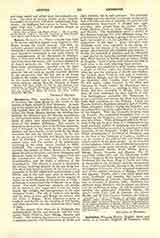

Andalusia. —This appellative is derived from Al-Andalus, the name given by the Arabs to the portion of Spain subject to their dominion. According to the opinion of D. Eduardo Saavedra, the name was applied after the battle of Las Naves in 1212 (when the Sierra Morena became the dividing line between the Christian and the Moorish possessions) to the territory under the control of the Moors, the limits of which were approximately the same as those of the present Andalusia. This country is situated in the southern part of the Iberian peninsula, and is bounded on the north by the provinces of Badajoz and New Castile, on the south by the Mediterranean Sea and the Atlantic Ocean, on the east by the provinces of Albacete and Murcia, and on the west by Portugal. Its total area is about 33,950 square miles, and the number of its inhabitants, according to the latest census (verified in 1900), 3,433,693. The principal mountain ranges that traverse this section are Sierra Morena in the north, Sierra Nevada in the south, and Sierra Almagrera and Sierra de Gador to the east. The largest rivers are the Guadalquivir, the Guadalete, Rio Tinto, the Guadalmedina, and the Genil, a tributary of the Guadalquivir. The climate in general is temperate, the section bordering directly on the sea being hot. The soil is very fertile in almost all the level country, especially in the flat arable land around Cordova and Seville, and in the wide open plain of Granada; it is poor in other sections, because of the scarcity of water—as in certain parts of the province of Cadiz—or because of innate properties of the soil—as in Alpujarras. The most important products are cereals, olives, beet-root, and sugarcane in the low lands; grapes, figs, oranges, and pomegranates in the ragas (irrigated lands). The oils of Cordova and Seville, and the wines of Jerez and Malaga are famous; also the raisins of Malaga. Much attention is given in Cordova and Seville to the breeding of fine horses, and these provinces are also famous for their breed of bulls.
At the present time there are in Andalusia two archbishoprics: Seville and Granada; and five bishoprics: Cadiz, Cordova, Jaen, Malaga, Almeria, and Guadix. The military department is represented by a capitania general, with headquarters at Seville and eight stations, one in each province. The judiciary is divided into two districts (audiencias territoriales), that of Seville and that of Granada; the political and administrative department is divided into eight provinces, each named from its capital: Seville, Cadiz, Huelva, Cordova, Jaen, Malaga, Granada, and Almeria. The Andalusians speak a dialect of the Spanish language, the chief difference being the pronunciation of the letter h, giving s the sound of z, and c the sound of s (in the syllables ce, ci), and the suppression of the final s. Many strangers visit Andalusia every year, especially in the spring, attracted by the beauty of its many historic monuments—preeminently, the cathedral and Alcazar of Seville, the cathedral of Cordova, and the Alhambra—and also by the typically national character of the Holy Week services at Seville, and of Corpus Christi at Granada. Fairs of great local interest are held in both cities in the week following these services.
Andalusia was inhabited in early historic times by a people of Iberian origin; the Turdetani occupied what are now the provinces of Seville and Huelva; the Turduli, Jaen, Cordova, and part of Granada; the Bastuli, Malaga, and the coast of Granada; and the Bastetani, Jaen, Guadix, Baza, and Almeria. To this region, called Tarshish in the Bible and Tartessos by Greek writers, the Phoenicians came, about the year 1100 B.C., settling in what is now Cadiz, and later spreading to Malaga, Adra, and Jete, all three celebrated for their deposits of salt. The Carthaginians succeeded the Phoenicians in power, and ruled over almost the whole of Andalusia until their expulsion by the Romans. Under the Roman dominion Andalusia formed a part of Farther Spain (Hispania Ulterior) during the Republic, and an independent province, called Boetica, in the time of the Empire. With the Germanic invasion came the Vandals, who established themselves here, to be followed by the Visigoths when the Vandals passed over into Africa. When Athanagild called the Byzantines to his aid, he gave them as a compensation the most southerly portion of Andalusia, but Leovigild, Suintila, and Sisebut succeeded in reuniting it to the monarchy of the Visigoths. Under the rule of the Emirs, subordinates of the Caliph of Damascus, and in the time of the Caliphate of Cordova,. Andalusia was the center of the political life and literary and artistic culture of the Arab people. At the downfall of the Caliphate (1030), it was subdivided into eleven independent states, some extremely small: Cordova, Seville, Carmona, Maron, Arcos, Niebla, Huelva, Malaga, Ronda, Granada, and Almeria. The Almoravides (1086-1129) and the Almohades (1129-1272) subjugated all this territory to their dominion. Ferdinand III, the Saint, King of Castile and Leon, in the middle of the thirteenth century, reconquered Jaen, Cordova, and Seville, leaving to the Arabs only the kingdom of Granada, which comprised the greater part of the present provinces of Malaga, Granada, and Almeria. Finally, after a war which lasted nine years, Ferdinand and Isabella, the Catholic, obtained possession of Granada, entering the capital city in triumph, January 2, 1492. Andalusia has produced many illustrious men in science, art, letters, and the profession of arms. It will be sufficient to mention the philosopher Francisco Suarez, the ascetic writer Fray Luis de Granada, the painter Murillo, and El Gran Capitan, Gonsalvo de Cordova.
EDUARDO DE HINOJOSA

